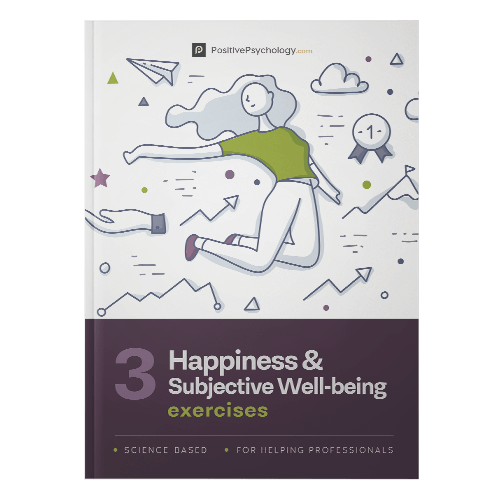Is Happiness Genetic? An Update on Recent Research

Are they born happy? Is it something they are doing differently from the rest of us? Or is it the environment they find themselves in?
Research suggests that all three factors shape our happiness (Røysamb et al., 2018).
Happiness is linked to some crucial outcomes in life, including health, longevity, work satisfaction, and even a good marriage (Larsen et al., 2017).
This article explores the impact of genes on our happiness while recognizing our capacity to change, and we will start with the most burning question.
Before you continue, we thought you might like to download our three Happiness & Subjective Wellbeing Exercises for free. These detailed, science-based exercises will help you or your clients identify sources of authentic happiness and strategies to boost wellbeing.
This Article Contains:
Is Happiness Genetic?
Research suggests wellbeing and life satisfaction — closely connected to happiness — are between 30 and 40% heritable (Røysamb et al., 2018). The rest is down to the life we lead and the environment in which we live. And it’s no surprise that “genetic factors appear to play an important role in most human characteristics” (Røysamb et al., 2018, p. 2).
While the impact of genetics on happiness is considerable, it is interesting to compare it with the heritability of IQ (one measure of human intelligence), which is believed to be around up to 80% – significantly higher (Plomin & Dreary, 2015).
Predispositions and genetics
A series of extensive meta-analysis studies comparing papers from various countries, including more than 30,000 pairs of twins, suggest that inheritance significantly affects happiness, subjective wellbeing, and psychological wellness across cultures (Røysamb et al., 2018).
Other research focusing on individual genes offers additional insight. One such gene is 5-HTTLPR, believed to be important in the control of mood-affecting serotonin. In one study, volunteers with a particular variant thought to benefit the transport of the neurotransmitter were found to be predisposed to avoiding negative images, preferring happier ones, such as pictures of puppies (Coghlan, 2009).
However, attentional bias is likely to be only one factor in having a sunny disposition. In fact, many other genes (and the predispositions they lead to) are likely to be involved (Coghlan, 2009).
Recent Genetic Research Into Happiness

To understand the nuances of genetic research into happiness, we sampled a few recent studies.
Nature versus nurture
Twin research is a vital tool in the study of genetics. Identical twins have the same genetics but may have experienced different environmental factors. Studying their psychological differences makes it possible to understand the genetic and environmental factors involved in happiness (Robson, 2022).
In 2018, a study of 1516 twins in Norway identified that 30% of the variance (the differences between individuals) in happiness was down to genetics (Røysamb et al., 2018).
The data also showed that there were specific aspects of their personality that when inherited from their parents, influenced this percentage, including (Røysamb et al., 2018):
- Neuroticism (leaving people more vulnerable to anxiety and depression)
- Extraversion (encouraging activity and more social behavior)
- Disposition toward positive emotions
The researchers concluded that “the happy, or satisfied personality thus seems to have low levels of anxiety and depression, and high levels of positive emotions and activity” (Røysamb et al., 2018, p. 6).
Seeking the happiness gene
We may be looking at the interaction of more genes than we first thought when it comes to happiness.
A recent study examining the integration of three distinct learning and memory systems (including conditioning, self-control, and self-awareness) identified 972 genes potentially involved in making us happy. Its findings suggest a psychobiological model for wellbeing that integrates the individual’s physical, mental, and spiritual aspects (Cloninger & Cloninger, 2019).
Comparing genomes
Not all genetic studies use twins. Some compare all the genetic information needed for a person to grow and develop, known as their genome, across unrelated individuals and groups (Larsen et al., 2017).
A 2022 study that contrasted individual genomes found a genetic basis for “general levels of happiness” (rather than momentary changes because of temporary circumstances) that also impacted brain structures that remain consistent throughout our lives (Ward et al., 2022).
According to Robert Waldinger, professor of psychiatry at Harvard Medical School, “you probably know people who are generally gloomy, and then you know people who are cheery and, almost no matter what, upbeat. We believe that this is somewhat biologically based, probably genetically determined” (Flood, 2023, para. 16).
The data also shows a close association between happiness and three of the five personality traits known as the Big 5: neuroticism, conscientiousness, and extraversion (Ward et al., 2022).
What Else Causes Happiness in Life?
While the degree of genetic influence on happiness is significant, environmental factors account for the remainder, including our physical wellbeing, the size and quality of our social network, our jobs, and even income, particularly how it compares with others (Robson, 2022).
Thankfully, research has told us a great deal about happiness.
Studying how to be happy
The longest study into happiness has been running since 1938. The Harvard Study of Adult Development began with 724 participants, including undergraduates and teenagers from disadvantaged backgrounds. And it continued with their children and grandchildren, including 1,300 direct descendants (Waldinger & Schulz, 2023).
Throughout their lives, they had regular medical checks, including brain scans, measures of stress hormones, blood tests, and psychological interviews, aiming to understand what makes a happy and meaningful life (Flood, 2023).
With 80 years of data spanning three generations, they broke down happiness into two pots: hedonic happiness (temporary and fluctuating) and eudaimonic happiness (living a meaningful and fulfilling life).
So, what was the most significant finding?
The power of relationships
“We found that the people in our study who kept prioritizing connections, and kept making those small decisions to connect day after day, were the people who stayed happier and healthier,” says Waldinger, author of The Good Life (Flood, 2023, para. 14).
The data showed that “having warm connections with other people predicts how long you stay healthy, how long your brain will stay sharp,” he continues (Flood, 2023, para. 8). Strong supportive relationships also help you manage stress, reduce the chance of coronary heart disease, and can even lower the risk of arthritis.
Good relationships also have a prolonged impact, even across decades. A 2016 study showed that the warmth of relationships with your parents as a child predicts how secure your attachment is to your closest partner 60 years later (Waldinger & Schulz, 2016).
It’s not about the money!
While society, media, and movies often suggest that money leads to happiness, this is only partially true. Research shows that despite Americans experiencing an increase in income, self-reported happiness remains essentially unchanged. Once individuals have moved out of the lowest levels of the economy, which typically have the highest levels of depression, increases in personal wealth are not necessarily accompanied by rising life satisfaction (Larsen et al., 2017).
Even lottery winners, having won large amounts of money, typically return to previous happiness levels within six months (Larsen et al., 2017).
Once we can meet our basic needs, further wealth does not lead to more happiness.
The Nordic effect and subjective wellbeing
Nordic countries, notably Finland, offer additional insight into other key factors influencing happiness and subjective wellbeing.
It seems that “low economic inequality, high levels of social trust and an effective welfare state” are vital to how good we feel about ourselves and our lives (Robson, 2022).
Finnish people trust one another and their institutions and are willing to have their taxes fund the state. And it works. According to the World Happiness Report produced annually by the United Nations, Finland is at the top of the happiness chart (Robson, 2022).
Is Happiness a Skill That Can Be Taught?

So what does it tell us about increasing our satisfaction with life?
According to the research, our happiness is not fixed. Despite the influence of genetics, it can be developed (Larsen et al., 2017).
The following skills, approaches, and mindsets have been generated from research and help increase our chance of happiness (Larsen et al., 2017):
- Spending quality time with friends, family, and loved ones
Humans are disposed to being sociable. Getting to know those around us and spending time with people we care about cultivates positive emotions. - Finding meaning in work and seeking challenges
Enjoyable work is crucial to happiness. If we are unhappy in the workplace, we must transform the environment and role or find a new challenge. - Being helpful to others
Showing gratitude and giving to others creates more robust connections and builds meaning in our lives. It also takes our minds off our problems and puts them in perspective. - Taking time off and focusing on self-care
We deserve to be happy, so taking time out to do the things we enjoy is vital. Schedule fun things into your life. - Maintaining physical health
Staying in shape boosts confidence and self-esteem and regains control over negative thoughts and emotions. Regular exercise provides significant emotional benefits. - Creating a plan but remaining open
Plan what you want to accomplish but remain open to new opportunities and experiences. Work toward your goals while being flexible rather than rigid. - Fostering optimism
Acting happy — singing, dancing, and laughing — even when alone creates positive emotions. Learning from past experiences that things usually work out, in the end, can transform your mindset and stop thoughts of failure from being self-fulfilling. - Keeping things in proportion
We all catastrophize from time to time, so it is good to remember to step back and regain perspective. Things aren’t always as bad as they seem.
“Most psychologists believe that happiness is something that people must work at” (Larsen et al., 2017, p. 334).
What makes a good life? – Robert Waldinger
How Does Happiness Change With Age?
Research consistently uncovers the same pattern. When it comes to age, we can plot happiness on a U-shaped curve (Becker & Trautmann, 2022).
The U-curve of happiness
With a few exceptions, most studies show that after the teenage years, happiness falls to an all-time low in middle age. After age 50, it may temporarily increase but then typically stagnates before regaining its height again as we age. It may flatten out or even decrease in old age (Becker & Trautmann, 2022).
“This dip in middle age is referred to as the U-shape of happiness and has been reported for a variety of countries” (Becker & Trautmann, 2022, p. 3626).
Some suggest that in our late 40s, the slump in happiness may result from what the West often refers to as a “midlife crisis.” It seems “the difference between our expectations for ourselves and what life actually holds for us often leads to disappointment and, in some cases, despair” (Suttie, 2020, para. 2). It is perhaps a result of the realization that the dreams we had for ourselves are not real.
And yet, we can protect ourselves. Happiness researcher David Blanchflower suggests that immersing ourselves in our community, friends, and family helps us cope by reducing loneliness and encouraging togetherness (Suttie, 2020).
Common Characteristics and Traits of a Happy Person

Here is a list of seven common features. Let us know if you can think of more.
- Humor
“People high in extraversion, locus of control, self-esteem, and optimism are happier because they engage in positive humor in daily life” (Ford et al., 2016, p. 320). Research shows that happiness is associated with self-enhancing humor rather than self-defeating or aggressive styles. - Kindness
Happy people are more likely to perform acts of kindness and are typically more grateful (Otake et al., 2006). - Focus on relationships
While paying attention to physical wellbeing is important, maintaining and building good relationships and social support is crucial (Mineo, 2017). - Warmth and gregariousness
Interpersonal facets that aid sociability appear to contribute to overall happiness (Røysamb et al., 2018). - Empathy
Closely associated with emotional awareness and intelligence, empathy can help begin and deepen relationships. It encourages us to share our understanding of one another, feel less alone, and improve overall happiness (Mineo, 2017). - Focus on accomplishments and goal attainment
The perceived gap between actual and ideal states often influences how we judge our satisfaction. “Personality facets such as competence, self-discipline, achievement-striving and dutifulness may be important in obtaining ideal states, and are thus likely to predict life satisfaction” (Røysamb et al., 2018, p. 2). - Disposition to positive emotions
Being disposed to seek out and experience more positive emotions contributes to experiences of joy and enthusiasm and may be vital in generating a good life (Røysamb et al., 2018).
Ultimately, many of the lessons we can take from positive psychology, with its goal of human flourishing, provide direct and indirect benefits to our overall happiness (Seligman, 2011).
Best Resources From PositivePsychology.com
While genetics is an essential element of happiness, our environment and our actions matter greatly. The strength and depth of the relationships we form contribute to our subjective wellbeing, psychological wellness, and, as the research confirms, our happiness.
Why not download our free positive relationships pack and give the tools a try? Some examples include:
- Connecting With Others by Self-Disclosure
Acceptance and understanding are vital to any relationship, improving communication and boosting emotional bonds. This exercise uses self-disclosure to strengthen connections and enhance intimacy. - The Sound Relationship House Inspection
Relationships can be nurtured and preserved through actions that build friendship, commitment, and trust. The relationship house metaphor helps couples examine how well their connection is functioning.
Other free resources include:
- About Your Partner
Use these five questions to get to know your partner better. - Friendship Ingredients
Reflecting on what makes you a good friend and what to look for in others can improve your connections. - Active Listening Reflection
This valuable reflection on active listening can improve understanding, absorbing, and responding to what is being said.
More extensive versions of the following tools are available with a subscription to the Positive Psychology Toolkit©, but they are described briefly below:
- A Letter From Your Best Day to Your Bad Days
Writing about the good days we experience can improve our recall of happy events and positive episodes in our lives.
On a day when you are motivated, feeling good about life, and happy, write a letter to yourself as a reminder of all that is good in your life.
-
- Address it to yourself.
- Start with a general message of support.
- Offer advice for coping.
- Include what you should keep in mind on bad days.
- Suggest something that you can be hopeful about.
Reflect on how you feel after writing the letter and the emotions and thoughts you experience when you read it on a difficult day.
- Creating Flow Experiences
You can experience flow as a journey outside of time where you perform at your best. It can be invigorating, with your entire focus on the task at hand, and lead to other positive emotions at the time or afterward.
-
- Step one – Write down as many flow-producing activities as you can think of.
- Step two – Choose the three you are most drawn to.
- Step three – Assess them. Which ones could you perform weekly?
- Step four – Reflect on the clarity of the goal, availability of immediate feedback, and the balance of skill versus challenge.
- Step five – Commit to ensuring the activity takes place.
If you’re looking for more science-based ways to help others develop strategies to boost their wellbeing, this collection contains 17 validated happiness and wellbeing exercises. Use them to help others pursue authentic happiness and work toward a life filled with purpose and meaning.
A Take-Home Message
Science tells us that between 30 and 40% of our happiness is genetic, so the rest is up to us and how we lead our lives.
Research into the genetics behind happiness uses twin studies and genome comparison and looks for associations with individual genes. Findings suggest many genes are involved, some directly, while others offer predispositions supporting related factors, such as forming and maintaining connections.
While our genes strongly influence our happiness, our environment and how we live our lives are even more critical.
Studies repeatedly identify the same factor: Strong, enduring, and healthy relationships are fundamental to our happiness. The investment we make in forming and maintaining our bonds with others increases positive feelings, subjective wellbeing, and happiness now and down the line.
According to happiness expert Robert Waldinger, “ultimately, if you build strong relationships and work on maintaining these, you’ll make it more likely you’ll have moment-to-moment happiness by building this bedrock sense that life is good” (Flood, 2023, para. 21).
Awareness that our happiness is not fixed, despite what we inherit from our parents, helps us create a mindset, learn skills, and engage in behavior that supports happy lives — our own and our clients.
We hope you enjoyed reading this article. Don’t forget to download our three Happiness Exercises for free.
- Becker, C. K., & Trautmann, S. T. (2022). Does happiness increase in old age? Longitudinal evidence from 20 European countries. Journal of Happiness Studies, 23, 3625–3654.
- Cloninger, K. M., & Cloninger, C. R. (2019). The psychobiology of the path to a joyful life: Implications for future research and practice. The Journal of Positive Psychology, 15(1), 74–83.
- Coghlan, A. (2009, February 25). ‘Happiness’ gene helps you look on the bright side. New Scientist. Retrieved February 7, 2023, from https://www.newscientist.com/article/dn16662-happiness-gene-helps-you-look-on-the-bright-side/.
- Flood, A. (2023, January 9). How to be happy, according to the longest-running study of happiness. New Scientist. Retrieved February 7, 2023, from https://www.newscientist.com/article/mg25734211-800-how-to-be-happy-according-to-the-longest-running-study-of-happiness/.
- Ford, T. E., Lappi, S. K., & Holden, C. J. (2016). Personality, humor styles and happiness: Happy people have positive humor styles. Europe’s Journal of Psychology, 12(3), 320–337.
- Larsen, R., Buss, D., Wismeijer, A., & Song, J. (2017). Personality psychology: Domains of knowledge about human nature. McGraw-Hill Education.
- Mineo, L. (2017, April 11). Over nearly 80 years, Harvard study has been showing how to live a healthy and happy life. Harvard Gazette. Retrieved February 8, 2023, from https://news.harvard.edu/gazette/story/2017/04/over-nearly-80-years-harvard-study-has-been-showing-how-to-live-a-healthy-and-happy-life/.
- Otake, K., Shimai, S., Tanaka-Matsumi, J., Otsui, K., & Fredrickson, B. L. (2006). Happy people become happier through kindness: A counting kindness intervention. Journal of Happiness Studies, 7(3), 361–375.
- Plomin, R., & Dreary, I. J. (2015). Genetics and intelligence differences: Five special findings. Molecular Psychiatry, 20, 98–108.
- Robson, D. (2022, January 19). What really makes people happy – and can you learn to be happier? New Scientist. Retrieved February 7, 2023, from https://www.newscientist.com/article/2305173-what-really-makes-people-happy-and-can-you-learn-to-be-happier/.
- Røysamb, E., Nes, R. B., Czajkowski, N. O., & Vassend, O. (2018). Genetics, personality and well-being. A twin study of traits, facets and life satisfaction. Scientific Reports, 8(1).
- Seligman, M. (2011). Flourish: A new understanding of happiness and well-being and how to achieve them. Nicholas Brealey.
- Suttie, J. S. (2020, March 6). Why we’re unhappiest in our late 40s. Greater Good Magazine. Retrieved February 7, 2023, from https://greatergood.berkeley.edu/article/item/why_were_unhappiest_in_our_late_40s.
- Waldinger, R. J., & Schulz, M. S. (2016). The long reach of nurturing family environments: Links with midlife emotion-regulatory styles and late-life security in intimate relationships. Psychological Science, 27(11), 1443–1450.
- Waldinger, R. J., & Schulz, M. S. (2023). The good life: Lessons from the world’s longest scientific study of happiness. Simon & Schuster.
- Ward, J., Lyall, L., Cullen, B., Strawbridge, R. J., Zhu, X., Stanciu, I., Aman, A., Niedzwiedz, C. L., Anderson, J., Bailey, M. E., Lyall, D. M., & Pell, J. (2022). A genome-wide association analysis of happiness: Consistent genetic effects across the lifespan and across genetic ancestries in multiple cohorts. bioRxiv. https://doi.org/10.1101/2022.04.05.487098.
Let us know your thoughts
Read other articles by their category
- Body & Brain (49)
- Coaching & Application (57)
- Compassion (26)
- Counseling (51)
- Emotional Intelligence (24)
- Gratitude (18)
- Grief & Bereavement (21)
- Happiness & SWB (40)
- Meaning & Values (26)
- Meditation (20)
- Mindfulness (45)
- Motivation & Goals (45)
- Optimism & Mindset (34)
- Positive CBT (28)
- Positive Communication (20)
- Positive Education (47)
- Positive Emotions (32)
- Positive Leadership (18)
- Positive Parenting (4)
- Positive Psychology (33)
- Positive Workplace (37)
- Productivity (16)
- Relationships (46)
- Resilience & Coping (36)
- Self Awareness (21)
- Self Esteem (38)
- Strengths & Virtues (31)
- Stress & Burnout Prevention (34)
- Theory & Books (46)
- Therapy Exercises (37)
- Types of Therapy (64)





What our readers think
This articles help me to understand my mind and i can have a glimps soul.
Thank you sp much.
One of the best article on happiness well researched and systematic.
Wow, a life changing piece of work. Most of us live in an environment that is a self created prison cell. Thanks & this is bulldozer that comes to smash the walls of this cell and sets my mind free.